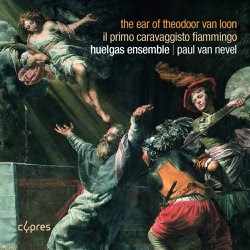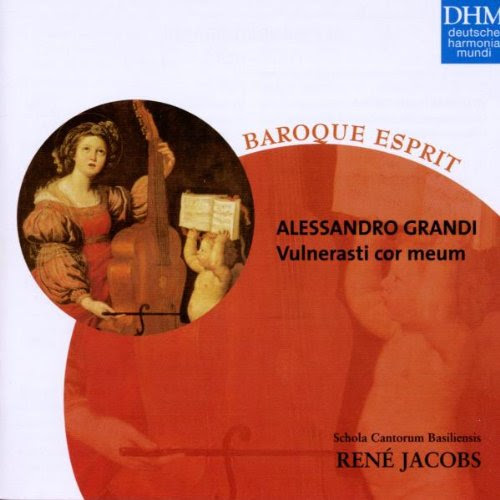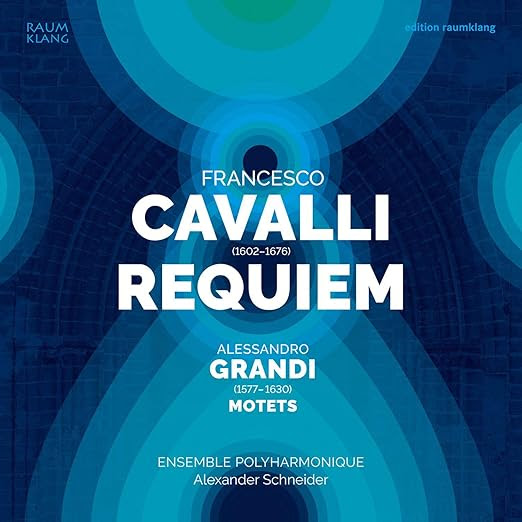Program: #21-45 Air Date: Nov 01, 2021
To listen to this show, you must first LOG IN. If you have already logged in, but you are still seeing this message, please SUBSCRIBE or UPGRADE your subscriber level today.
The ear of Flemish artist Theodor van Loon, who studied in Rome; sacred music of Alessandro Grandi; and the Requiem of Francesco Cavalli.
I. The Ear of Theodor van Loon (Huelgas Ensemble/Paul van Nevel). Cypres CDCYP1679.

D. James Ross
2. Paolo Quagliati: Quando miro il bel volto
3. Felice Anerio: Tibi laus, tibi gloria
4. Luca Marenzio: O voi che sospirate
5. Francesco Soriano: In illo tempore
6. Domenico Mazzocchi: Ahi, chi m'aita
7. Domenico Mazzocchi: Chiudesti i lumi Armida
8. Géry de Ghersem: Agnus Dei
9. Pedro Rimonte: Luna que reluces
10. Nicolaus a Kempis: Symphonia Iii
11. Nicolaus a Kempis: Ad te suspiro
12. Peter Philips: Le bel Ange du Ciel
13. Giuseppe Zamponi: Dies irae dies illa
14. Peter Philips: Hodie nobis de caelo
II. Alessandro Grandi: Vulnerasti cor meum (Schola Cantorum Basiliensis/Rene Jacobs). DHM CD 05472 77857 2.

In the 1620's sacred music underwent a significant change, out went the polychoral techniques of the Gabrielis and in came the new concerted style. A more intimate style with a few solo voices and instruments, with a greater emphasis on virtuosity. Monteverdi used this style in his later church music, but it was fully developed by his colleagues and followers such as Alessandro Grandi.
Grandi had an advantage over colleagues such as Monteverdi and Gabrieli in that he was a singer. His art revolves around the expression of the text, using the music to bring out the prosody of the words. His earliest motets were published in 1610 and they are admirably lacking in youthful inexperience. 'O quam pulchra es' uses three voices in an almost madrigalian setting of words from the Song of Songs.
Grandi's works crop up in the catalogue mainly in surveys of Monteverdi's contemporaries. Despite his importance in early 17th century Italian music, record companies have mainly cast him in Monteverdi's shadow, so it is pleasant to welcome this CD back. It has an enviable line up of singers with the young Andreas and Elisabeth Scholl alongside René Jacobs and Maria Cristina Kiehr.
The motets all receive fine performances. This vocal chamber music requires a good interplay between performers and those on this record are generally admirable. Jacobs sings two of the solo motets, 'Salve Regina' with its cornet obliggati and 'O quam tu pulchra est'. Whilst I was able to admire his artistry greatly, not everyone will like his distinctive resinous tone. But these are two of the most affecting motets on the record and Jacobs' way with the words is hauntingly persuasive. Though all the artists on the disc are excellent, Jacobs proves to be the most penetratingly responsive to the text.
The admirable cornettists are Jean Tubery, and William Dongois and their playing combines discretion and subtlety along with virtuoso effect. They appear on two further tracks. 'Transfige', a solo motet well sung by Gerd Türk with his mellifluous, bright, if slightly unvarying tenor voice and 'Bone Jesu verbum patris', a lovely duet charmingly sung by Elisabeth and Andreas Scholl, who blend exquisitely. The two cornets beautifully balance the two vocalists and show off Grandi's expertise with the new structural developments in sacred music.
Dramatic and structural interest are rarely absent from these lovely works. Solo voices are counterbalanced by two violins in three of the motets. 'Osculetur me', in which Andreas Scholl brings to bear his creamy alto voice; 'Virgo prudentissima' sung with a brilliant urgency by Elisabeth Scholl; 'Vulnerasti cor meum' sung by the bright toned Maria Cristina Kiehr who gets the bulk of the soprano solos.
In the multi-voiced motets, some are in the more traditional style of the late 16th century, like the 5-voiced setting of Job's lament, 'Versa est'. But others reflect Grandi's more recent concerns. 'Heu mihi! - Quid ploras?' is a conversation between the despairing sinner (hauntingly sung by Gerd Türk) and God (sung by Andreas Scholl, Otto Rastbichler and Ulrich Messthaler). 'Quemadmodum desiderat' is another dialogue, this time between two voices (Maria Christina Kiehr and Ulrich Messthaler). a lover and beloved, which ends with a hymn to the Virgin!
The motet 'Plorabo die ac nocte' uses a text which links the lamentations of Jeremiah with a pain-filled Marian lament. The text is sung by each soloist in turn. But, in an effect reminiscent of a Greek chorus, all soloists join together at the end of each solo. But the most remarkable is possibly 'Missus est Gabriel'. This setting of the annunciation uses St. Luke's Gospel, allocated to Evangelist (Ulrich Messthaler, singing with a wonderfully dark tone), Angel (Gerd Türk) and Virgin (Andreas Scholl). But this mini-oratorio increases the drama by adding an off-stage chorus (sopranos Maria Cristina Kiehr and Elisabeth Scholl) who constantly sing the praises of the virgin, providing a chorus which comments on and interrupts the main dialogue.
All the items on this CD are gems. Grandi had great melodic gifts and good ear for dramatic presentation of his texts. A singer himself, his vocal lines are always effective and grateful. All the singers on this recording are admirable and it manages to showcase the talents of a remarkable group of young singers and instrumentalists.
Grandi's motets deserve to be better known, but his works have been difficult to come by in performing editions. This seems to be the only CD in the catalogue devoted solely Grandi's works, so it is pleasing to see its return and the artists are also to be commended for their musicological research. It is a shame that the CD booklet does not manage to print the texts of the motets. Grandi was such a text based composer that one misses the opportunity of following the words in translation. Not all of these texts are well known and not everyone has the requisite Latin.
This is a lovely CD to listen to in one sitting or simply to dip into. I can highly recommend it.
-- Robert Hugill, MusicWeb International
| 1 | O Quam Tu Pulchra Es | 2:54 |
| 2 | In Lectulo Meo | 2:08 |
| 3 | Versa Est | 3:26 |
| 4 | Salve Regina | 4:01 |
| 5 | Quemadmodum Desiderat | 5:01 |
| 6 | O Intemerata | 3:21 |
| 7 | Osculetur Me | 3:56 |
| 8 | Ave Regina | 2:27 |
| 9 | Bone Jesu Verbum Patris | 4:57 |
| 10 | Missus Est Gabriel (Dialogo) | 8:27 |
| 11 | Virgo Prudentissima | 2:56 |
| 12 | O Quam Tu Pulchra Es | 3:14 |
| 13 | Domine, Ne In Furore | 3:22 |
| 14 | Vulnerasti Cor Meum | 4:05 |
| 15 | Heu Mihi - Quid Ploras (Dialogo) | 4:13 |
| 16 | Transfige | 6:07 |
| 17 | Plorabo Die Ac Nocte |
III. Francesco Cavalli: Requiem (Ensemble Polyharmonique/Alexander Schneider). Raum Klang CD RK 3601.

A man, famous throughout Europe whose compositions, both sacred and secular, enjoyed great success.A composer who set to music the whole spectrum of human passions and vicissitudes, who with the most modest means achieves extraordinary effects and with whose abundantly variegated forms, ranging from recitativo secco to full-blown arias a panoply of possibilities was displayed, unique in the history of opera.
When Venetian Opera was at its acme in mid17th century Cavalli represented one of the chief attractions of the operatic season, a composer whose breathtaking productivity dazzled, even in the hive of activity which was then the luxurious lagoon city.His works pointed the way for the as yet young and unestablished form of opera.Whereas only three operas by Cladio Montiverdi have come down to us, we possess almost thirty by Cavalli. His Giasone from 1649 was one of the most successful operas of the 17th century altogether.One of the high points in Cavalli’s life was the invitation by the French court, on the occasion of the Louis XIV’s wedding festivities in 1660.
Two operas by Cavalli, Xerse and L’Ercole Amante, were performed in the great “Galerie” of the Palais de Louvre and in the Tuileries respectively, the latter with inclusions for ballet by a certain Jean-Baptiste Lully, who was to go on to become one of Europe’s most influential composers.Unfortunately these ventures were not smiled on by the gods. Dissapointed and perhaps even a little embittered by inauspicious circumstances and by the anti-Italian machinations of his French homologues which caused L’Ercole Amante to “flop”, Cavalli returned to Venice in 1662, where he would henceforward dedicate himself more to sacred compositions.
What happened to him now can best be described as a religious turning point after which he would turn his focus inwards. This reaction is well known by those who have undergone life-changing traumas. In this way, and to a great extent psychologically sensibilised, Cavalli’s later church music can be seen as an attempt to digest and invest with higher meaning that which had “thrown him”, in spite of much initial worldly success. Hardly surprising in this context were his efforts to dictate exactly how he wished his own funeral to be conducted. This was a return to the spiritual and religious foundation on which his life as a child and adolescent had been founded.
Cavalli’s sacred compositions comprise two concert-style Masses, an Oratorio, three cycles of Vespers, five settings of the Magnificat, more than two dozen other liturgical compositions and finally the Missa pro defunctis per octo vocibus, composed presumably between 1673 and 1675 but unpublished in Cavalli’s lifetime. In this, his last work, his “opus ultimum” Cavalli turns to the roots of his oeuvre and bequeathes to us a vision of the music which had indented itself on his soul whilst still very young.It displays a view of his years in the choir of San Marco cathedral in Venice under the Aegide of Monteverdi and Alessandro Grandi (1618 maestro del canto, later assistant conductor) where Cavalli began his formidable musical career.As a singer, organist and from 1688 as maestro di capella he had a life-long connection with the cathedral of San Marco in Venice.
Perceiving his own life to be nearing its end, Cavalli wrote this Requiem for his own demise. In his will he left precise instructions for the organist.(Hereby, a sort of early baroque “Gesamtkunstwerk” was created, comparable to the plan by Heinrich Posthumus Reuss, in which a central place is taken by Heinrich Schütz’s “Musikalischen Exequien”). Cavalli required for this an opulent orchestration : the San Marco singers in total, 2 violins, 4 violas, 2 cornettos, 2 theorboes, trombones, a dulzian, a violone and no less than 3 organs!
He also ordained that the work should be performed twice yearly in his memory. Looking in from the outside it would seem that the work was intended to impress, as a sort of musical memorial. But in its inner core can be discerned both the piety and the loneliness of a man whose wife had predeceased him and whose marriage was without issue, i.e. had remained childless.
This Mass for the dead, composed in the so-called “stilo antico” was not intended for Cavalli’s contemporaries, but is aiming for eternity. Enriched by his multifarious experiences Cavalli is primarily concerned with allowing the text to irradiate the whole work. His refined theological and philosophical innovations enable past, present and future to be summed up simultaneously. His music draws us into the early baroque, makes use of elements of the high baroque style and even points towards the style known in German as “Empfindsamkeit”.A perpetually Palestrina- inspired imitative style alternates continuously with passages of declamatory, homophony, a sort of musical genuflection to the Venetian double choir style of Giovanni Gabrieli. The harmony and the solemn pace are reminiscent of the style of Tomas Luis de Victoria’s “Officium Defunctorum”.
One unusual particular of the Missa pro defunctis is the Dies Irae, which inimitably unites a terrifying vision of the last judgement with the believer’s hope for salvation.The ruling eight-part texture is skilfully placed in stark contrast with intimate two or three-part passages. There are references to Monteverdi’s Madrigali Guerrieri with telling onomatopoeia. Musical figures illustrating both “martelli” (hammers) and “aqua” (water) are discernible in such phrases as “dies irae” and “cum resurget”. On hearing the sections “voca me” and “lacrymosa” one could be forgiven for thinking that Mozart must have known this music. One novelty is that the usual Gregorian chant elements are very largely noticeable by their absence. Only in the Introit in the verse “te decet” and in the “agnus dei” are the traditional chants, whether in unison or clothed in harmony, to be heard.
The ensemble polyharmonique wishes to show the quintessence of this music by employing a solo cast of only eight singers and basso continuo. Cavalli’s introspective yearning is highlighted by the use of postmodern digital means. In an era where a live performance in a liturgical context has become an absolute exception, our CD springs into the breach and serves to refresh our collective memories with the wonders of the past.Our programme combines motets seathing with emotion and the more intimate “spiritual concerts” of Alessandro Grandi juxtaposed with a setting of the Requiem text with all his very personal perceptions by Francesco Cavalli. We are invited to participate in 17th century spiritual attitudes which fascinate us to this very day, tinged as they are by Renaissance Humanism, the awareness of the impermanence of life and the belief that at death we will transcend to a better life.
This picture of life, in which the idea of an ungraspable higher order of things ordains our existence, gives this music the utmost value and provides us with our most urgently needed life’s companion.
Alexander Schneider – Prof. Jonathan Alder (Rendering into the English tongue)
| 1 | Requiem Aeternam (Introitus)
Composed By – Francesco Cavalli
|
5:04 |
| 2 | Kyrie - Christe - Kyrie
Composed By – Francesco Cavalli
|
3:47 |
| 3 | Exaudi Deus (Motette à 5) Composed By – Alessandro Grandi |
4:53 |
| 4 | Dies Irae - Quantus Tremor - Tuba Mirum (Sequentia) Composed By – Francesco Cavalli |
2:03 |
| 5 | Mors Stupebit - Liber Scriptus - Judex Ergo - Quid Sum Miser Composed By – Francesco Cavalli |
2:38 |
| 6 | Rex Tremendae - Recordare - Quaerens Me - Juste Judex - Ingemisco - Qui Mariam Composed By – Francesco Cavalli |
5:14 |
| 7 | Preces Meae - Inter Oves - Confutatis - Oro Supplex - Lacrymosa - Pie Jesu - Dona Eis Requiem Composed By – Francesco Cavalli |
5:40 |
| 8 | In Te Domine Speravi (Concerto à 2) Composed By – Alessandro Grandi |
3:06 |
| 9 | O Bone Jesu (Motette à 5) Composed By – Alessandro Grandi |
2:58 |
| 10 | Domine Jesu Christe - Quam Olim Abrahae Composed By – Francesco Cavalli |
2:21 |
| 11 | Hostias - Quam Olim Abrahae Composed By – Francesco Cavalli |
2:08 |
| 12 | Exaudi Domine (Concerto à 2) Composed By – Alessandro Grandi |
2:29 |
| 13 | Versa Est In Luctum (Motette á 5) Composed By – Alessandro Grandi |
4:18 |
| 14 | Sanctus Dominus - Benedictus Composed By – Francesco Cavalli |
3:26 |
| 15 | Da Pacem Domine (Concerto à 2) Composed By – Alessandro Grandi |
2:31 |
| 16 | Agnus Dei Composed By – Francesco Cavalli |
Composer Info
Theodor van Loon, Francesco Soriano, Paolo Quagliati, Felice Anerio, Luca Marenzio, Domenico Mazzocchi, Géry de Ghersem, Pedro Rimonte, Nicolaus a Kempis, Peter Philips, Giuseppe Zamponi, Peter Philips, Alessandro Grandi, Francesco Cavalli,
CD Info
Cypres CDCYP1679, DHM CD 05472 77857 2, Raum Klang CD RK 3601